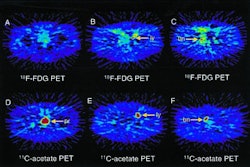
This is the fourth in a monthly series of coding-specific articles for U.S.-based radiology practitioners that appear each month on AuntMinnie.com courtesy of Coding Strategies Incorporated. If you'd like to offer your comments about the material, please e-mail [email protected].
By Melody W. Mulaik
Coding Strategies Incorporated

The Centers for Medicare and Medicaid Services (CMS) has concluded that the evidence on the use of PET is sufficient to support broad coverage for diagnosis, staging, and restaging for six types of cancer (non-small cell lung, esophageal, colorectal, lymphoma, melanoma, and head/neck), and for limited diagnostic use for two non-oncologic indications (refractory seizures and myocardial viability following inconclusive SPECT only).
Today, the CMS announced it would cover the use of PET for the management of care for patients with breast cancer. Alzheimer’s disease/dementia have been referred to the Medicare Coverage Advisory Committee (MCAC) Diagnostic Imaging Panel for consideration.
Effective July 1, 2001, Medicare coverage was expanded and the requirement of specialized PET modifiers was eliminated.
In order for scans to be covered by Medicare, the following conditions must be met:
- Claims for payment must include any information Medicare requires to ensure that the PET scans performed were reasonable and necessary, did not unnecessarily duplicate other covered diagnostic tests, and did not involve investigational drugs or procedures using investigational drugs, as determined by the FDA.
- For use in oncologic diagnosis, PET is covered in clinical situations where the results may assist in avoiding an invasive diagnostic procedure, or in which the results may assist in determining the optimal location to perform an invasive diagnostic procedure. PET is not covered for other diagnostic uses, and is not covered for screening services.
- The PET scan entity submitting claims for payment must keep Medicare required records on file for each patient for whom a PET scan claim is made that documents the specific clinical question that will be answered by the imaging study.
- For staging and restaging, coverage for PET is subject to two conditions:
- The stage of the cancer remains in doubt after completion of a standard diagnostic workup, including conventional imaging (CT, MR, or US)
- Clinical management of the patient would differ depending on the stage of the cancer identified. Use of PET would also be considered reasonable and necessary if it could potentially replace one or more conventional imaging studies.
- The scan completed must not be used to monitor tumor response during a planned course of therapy when no change in therapy is being contemplated.
- PET is not covered for other diagnostic uses, and is not covered for screening (testing of patients without specific symptoms).
New PET guidelines
On November 27, 2001, CMS released Transmittal AB-01-168, Change Request 1886 -- The Use of Gamma Cameras and Full Ring and Partial Ring PET Scanners for PET Scans. This decision does not change the covered clinical indications beyond the changes that took effect on July 1, 2001. These new Healthcare Common Procedure Coding System (HCPCS) codes are provided to clarify the type of PET scanner used by clinical indication.
< P>All PET scans are covered for FDA approved full-ring and partial-ring systems. The following scans are covered for certain coincidence systems:- Characterization of single pulmonary nodules
- Initial staging of lung cancer (NSLC)
- Determining location of colorectal tumors if rising CEA level suggests recurrence
- Staging or restaging of lymphoma only when used as an alternative to a gallium scan
- Evaluating recurrence of melanoma prior to surgery as an alternative to a gallium scan
"Certain coincidence systems" refers to the systems that have all the following features:
- Crystal at least 5/8-inch thick
- Techniques to minimize or correct for scatter and/or randoms, and
- Digital detectors and iterative reconstruction
"Certain coincidence systems" must have all three design features. Scans performed with gamma camera PET systems with crystals thinner that 5/8-inch will not be covered by Medicare. In addition, scans performed with systems with crystals greater than or equal to 5/8-inch in thickness, but that do not meet the other listed design characteristics are not covered by Medicare.
Effective January 1, 2002 existing HCPCS codes G0210-G0230 have expanded definitions to include the verbiage "full- and partial-ring PET scanners only" in their definitions to properly reflect the type of PET scanner used. Also effective January 1, 2002, the following new G codes were implemented to indicate if a gamma camera is used for the PET scan.
- G0231 - PET, whole body, for recurrence of colorectal or colorectal metastatic cancer; gamma cameras only
- G0232 - PET, whole body, for staging and characterization of lymphoma; gamma cameras only
- G0233 - PET, whole body, for recurrence of melanoma or melanoma metastatic cancer, gamma cameras only
- G0234 - PET, regional or whole body, for solitary pulmonary nodule following CT, or for initial staging of non-small cell lung cancer; gamma cameras only.
Watch for local medical review policies from your carrier regarding medical necessity requirement and utilization of all of the PET scan codes.
By Melody MulaikAuntMinnie.com contributing writer
February 28, 2002
Melody Mulaik is president of Coding Strategies Incorporated.
Related Reading
CMS expands PET coverage to breast cancer patients, February 28, 2002
New Year brings new coding and bundling changes, January 18, 2002
New diagnosis guidelines could affect your operations and reimbursement, December 18, 2001
Order compliance equals payment for outpatient radiologists, November 19, 2001
Copyright © 2002 Coding Strategies Incorporated




















